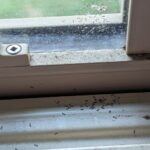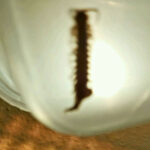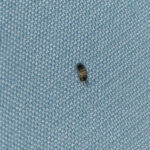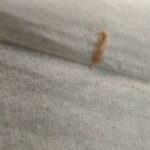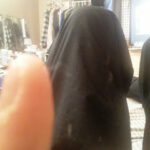
“What are these?” asks this reader about the minuscule, larvae-looking creatures in the photographs she sent us. Although no more context is provided, this photo of a cluster of a black-headed, gray-bodied creatures is all too familiar, and we know exactly what these are.
The creatures in our reader’s photos are newly-hatched armyworms. Armyworms are the larval form of the armyworm moth, and just as they hatch in a large group, they travel in large groups too once they have matured. This is why a group of caterpillars is called an army! Although these critters are completely harmless in the home, being neither dangerous to humans, nor pets, the armyworm is a notorious agricultural pest. Their diet consists of a great number of crops and other plants; the list alone could comprise an entire article. Since they are birthed in such large cloisters, and will travel in the same size groups, they can be incredibly destructive when they infest an area of plants. In fact, the FAO (Food and Agricultural Organization) considers the fall armyworm (the most common species of the armyworm) an “international threat” and as such has developed the ‘Global Action for FAW Control’, which is an initiative that aims to educate about and control the fall armyworm problem that many farms face.
Now, unless our reader is a farmer, or has a large garden with crops, she does not have anything to really worry about. Either way, we recommend that she sweep the larvae into a dustpan and deposit them somewhere outside where they will not be a threat to someone’s plants, but where they can still survive (perhaps a forest, if possible). If our reader does have crops of some kind, then she should do the same and with great haste, but then she should also check her crops for signs of infestation (bite marks on the leaves or stems of plants can be a sign that there is an ongoing infestation). She can also check for roaming larvae either on top of or by sifting through some of the top layers of the soil. If she does discover an infestation, we recommend handpicking any found larvae and also contacting pest control (or some kind of qualified professional) to take a look at this. Armyworm infestations can often get out of control, and could be difficult for any one person to deal with without the proper education and equipment.
In conclusion, the small, gray worms our reader discovered are immature armyworms. These creatures are not harmful to humans or animals, but if our reader does have, or lives near a farm, then they are cause for concern. We hope that our reader gets these armyworms moved soon and that she does not have to worry for any crops that she may own.
All About Worms is always free, always reader-supported. Your tips via CashApp, Venmo, or Paypal are appreciated! Receipts will come from ISIPP Publishing.
You might also find these guys interesting!





